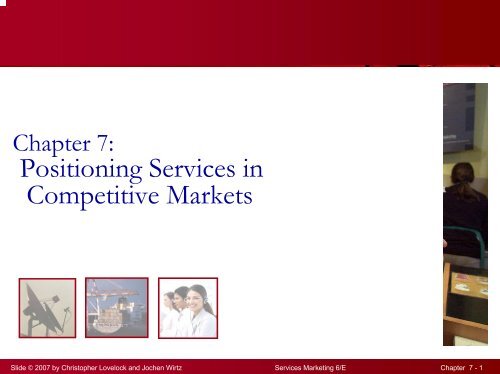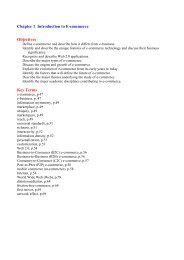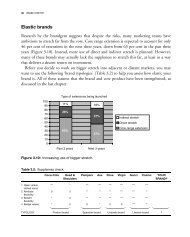Summary for Chapter 7: Positioning Services in Competitive Markets
Summary for Chapter 7: Positioning Services in Competitive Markets
Summary for Chapter 7: Positioning Services in Competitive Markets
Create successful ePaper yourself
Turn your PDF publications into a flip-book with our unique Google optimized e-Paper software.
<strong>Chapter</strong> 7:<br />
<strong>Position<strong>in</strong>g</strong> <strong>Services</strong> <strong>in</strong><br />
<strong>Competitive</strong> <strong>Markets</strong><br />
Slide © 2007 by Christopher Lovelock and Jochen Wirtz <strong>Services</strong> Market<strong>in</strong>g 6/E <strong>Chapter</strong> 7 - 1
Overview of <strong>Chapter</strong> 7<br />
� Focus Underlies the Search <strong>for</strong> <strong>Competitive</strong> Advantage<br />
� Market Segmentation Forms the Basis <strong>for</strong> Focused<br />
Strategies<br />
� Service Attributes and Levels<br />
� <strong>Position<strong>in</strong>g</strong> Dist<strong>in</strong>guishes a Brand from Its Competitors<br />
� Internal, Market, and Competitor Analyses<br />
� Us<strong>in</strong>g <strong>Position<strong>in</strong>g</strong> Maps to Plot <strong>Competitive</strong> Strategy<br />
� Chang<strong>in</strong>g <strong>Competitive</strong> <strong>Position<strong>in</strong>g</strong><br />
Slide © 2007 by Christopher Lovelock and Jochen Wirtz <strong>Services</strong> Market<strong>in</strong>g 6/E <strong>Chapter</strong> 7 - 2
Focus Underlies the Search <strong>for</strong><br />
<strong>Competitive</strong> Advantage<br />
� Intensify<strong>in</strong>g competition makes it important to<br />
differentiate products<br />
� In mature market, only way to grow may be to take a<br />
share from competitors<br />
� Must be selective <strong>in</strong> target<strong>in</strong>g customers<br />
� Rather than compete <strong>in</strong> an entire market, firm must<br />
focus ef<strong>for</strong>ts on customers it can serve best<br />
� Emphasize competitive advantage on those attributes<br />
that will be valued by customers <strong>in</strong> target segment(s)<br />
Slide © 2007 by Christopher Lovelock and Jochen Wirtz <strong>Services</strong> Market<strong>in</strong>g 6/E <strong>Chapter</strong> 7 - 3
Stand<strong>in</strong>g Apart from the Competition<br />
A bus<strong>in</strong>ess must set itself apart from its competition.<br />
To be successful it must identify and promote itself<br />
as the best provider of attributes that are<br />
important to target customers<br />
George S. Day<br />
Slide © 2007 by Christopher Lovelock and Jochen Wirtz <strong>Services</strong> Market<strong>in</strong>g 6/E <strong>Chapter</strong> 7 - 4
Basic Focus Strategies <strong>for</strong> <strong>Services</strong><br />
(Fig 7.1)<br />
NUMBER OF<br />
MARKETS<br />
SERVED<br />
Many<br />
Few<br />
BREADTH OF SERVICE OFFERINGS<br />
Narrow Wide<br />
Service<br />
Focused<br />
Fully Focused<br />
(Service and<br />
market<br />
focused)<br />
Unfocused<br />
(Everyth<strong>in</strong>g<br />
<strong>for</strong> everyone)<br />
Market<br />
Focused<br />
Source: Robert Johnston “Achiev<strong>in</strong>g Focus <strong>in</strong> Service Organizations,” The Service Industries Journal, Vol. 16, January 1996, pp. 10–20<br />
Slide © 2007 by Christopher Lovelock and Jochen Wirtz <strong>Services</strong> Market<strong>in</strong>g 6/E <strong>Chapter</strong> 7 - 5
Risks and Opportunities of a<br />
Fully Focused Strategy<br />
� Opportunities<br />
� Develop<strong>in</strong>g recognized expertise <strong>in</strong> a well-def<strong>in</strong>ed niche may<br />
provide protection aga<strong>in</strong>st would-be competitors<br />
� Allows firms to charge premium prices<br />
� Risks<br />
� Market may be too small to generate needed volume of bus<strong>in</strong>ess<br />
� Demand <strong>for</strong> a service may be displaced by generic competition from<br />
alternative products<br />
� Purchasers <strong>in</strong> chosen segment may be susceptible to economic<br />
downturn<br />
Slide © 2007 by Christopher Lovelock and Jochen Wirtz <strong>Services</strong> Market<strong>in</strong>g 6/E <strong>Chapter</strong> 7 - 6
Market Segmentation Forms the<br />
Basis <strong>for</strong> Focused Strategies<br />
Slide © 2007 by Christopher Lovelock and Jochen Wirtz <strong>Services</strong> Market<strong>in</strong>g 6/E <strong>Chapter</strong> 7 - 7
Market Segmentation<br />
� Firms vary widely <strong>in</strong> ability to serve different types of<br />
customers<br />
� Adopt strategy of market segmentation, identify<strong>in</strong>g those parts of<br />
market that can be served best<br />
� A market segment is composed of a group of buyers shar<strong>in</strong>g common:<br />
― Characteristics<br />
― Needs<br />
― Purchas<strong>in</strong>g behavior<br />
― Consumption patterns<br />
� Market and Micro Segmentation<br />
� Creation of customer databases and sophisticated<br />
analytical software enable firms to adopt:<br />
― Micro segmentation strategies target small<br />
groups of customers shar<strong>in</strong>g certa<strong>in</strong> relevant<br />
characteristics at a specific po<strong>in</strong>t <strong>in</strong> time<br />
― e.g., Royal Bank of Canada (Best Practices 7.1)<br />
Slide © 2007 by Christopher Lovelock and Jochen Wirtz <strong>Services</strong> Market<strong>in</strong>g 6/E <strong>Chapter</strong> 7 - 8
Identify<strong>in</strong>g and Select<strong>in</strong>g<br />
Target Segments<br />
� A target segment is one that a firm has selected from among<br />
those <strong>in</strong> the broader market and may be def<strong>in</strong>ed on the<br />
basis of multiple variables<br />
� Must analyze market to determ<strong>in</strong>e which segments offer<br />
better opportunities<br />
� Target segments should be selected with reference to<br />
� Firm’s ability to match or exceed compet<strong>in</strong>g offer<strong>in</strong>gs directed at the<br />
same segment<br />
� Not just profit potential<br />
� Some “underserved” segments can be huge, especially poor<br />
consumers <strong>in</strong> emerg<strong>in</strong>g economies<br />
� For example: Banco Azteca <strong>in</strong> Mexico (Service Perspectives 7.2)<br />
Slide © 2007 by Christopher Lovelock and Jochen Wirtz <strong>Services</strong> Market<strong>in</strong>g 6/E <strong>Chapter</strong> 7 - 9
Service Attributes and Levels<br />
Slide © 2007 by Christopher Lovelock and Jochen Wirtz <strong>Services</strong> Market<strong>in</strong>g 6/E <strong>Chapter</strong> 7 - 10
Develop<strong>in</strong>g Right Service Concept <strong>for</strong> a<br />
Specific Segment<br />
� Use research to identify and prioritize which attributes of<br />
a given service are important to specific market segments<br />
� Individuals may set different priorities accord<strong>in</strong>g to:<br />
� Purpose of us<strong>in</strong>g the service<br />
� Who makes decision<br />
� Tim<strong>in</strong>g of use<br />
� Whether service is used alone or with a group<br />
� Composition of that group<br />
Slide © 2007 by Christopher Lovelock and Jochen Wirtz <strong>Services</strong> Market<strong>in</strong>g 6/E <strong>Chapter</strong> 7 - 11
Important versus Determ<strong>in</strong>ant Attributes<br />
� Consumers usually choose between alternative service<br />
offer<strong>in</strong>gs based on perceived differences between them<br />
� Attributes that dist<strong>in</strong>guish compet<strong>in</strong>g services from one<br />
another are not necessarily the most important ones<br />
� Determ<strong>in</strong>ant attributes determ<strong>in</strong>e buyers’ choices<br />
between compet<strong>in</strong>g alternatives<br />
� Service characteristics that are important to purchasers<br />
� Customers see significant differences between compet<strong>in</strong>g<br />
alternatives on these attributes<br />
Slide © 2007 by Christopher Lovelock and Jochen Wirtz <strong>Services</strong> Market<strong>in</strong>g 6/E <strong>Chapter</strong> 7 - 12
Establish<strong>in</strong>g Service Levels and Tiers<br />
� Need to make decisions on service levels—level of<br />
per<strong>for</strong>mance firm plans to offer on each attribute<br />
� Easily quantified attributes are easier to understand and<br />
generalizable—e.g., vehicle speed, physical dimensions<br />
� Qualitative attributes are ambiguous and subject to <strong>in</strong>dividual<br />
<strong>in</strong>terpretation—e.g., physical com<strong>for</strong>t, noise levels<br />
� Can often segment customers accord<strong>in</strong>g to will<strong>in</strong>gness to<br />
trade off price versus service level<br />
� Service tier<strong>in</strong>g: <strong>Position<strong>in</strong>g</strong> strategy based on offer<strong>in</strong>g<br />
several price-based classes of service concept<br />
� Packag<strong>in</strong>g a dist<strong>in</strong>ctive level of service across many attributes<br />
� Common <strong>in</strong> hotels, airl<strong>in</strong>es, car rentals, computer hardware, and<br />
software support etc.<br />
Slide © 2007 by Christopher Lovelock and Jochen Wirtz <strong>Services</strong> Market<strong>in</strong>g 6/E <strong>Chapter</strong> 7 - 13
Examples of Service Tier<strong>in</strong>g <strong>in</strong><br />
Different Industries (Table 7.1)<br />
Industry Tiers Key Service Attributes and<br />
Physical Elements Used <strong>in</strong> Tier<strong>in</strong>g<br />
Lodg<strong>in</strong>g Star or diamond<br />
rat<strong>in</strong>gs (5 to 1)<br />
Airl<strong>in</strong>e Classes<br />
(<strong>in</strong>tercont<strong>in</strong>ental):<br />
first, bus<strong>in</strong>ess,<br />
premium economy,<br />
economy<br />
Architecture; landscap<strong>in</strong>g; room size;<br />
furnish<strong>in</strong>gs and décor; restaurant facilities and<br />
menus; room service hours; array of services<br />
and physical amenities; staff<strong>in</strong>g levels; caliber<br />
and attitudes of employees<br />
Seat pitch; seat width and recl<strong>in</strong><strong>in</strong>g capability;<br />
meal and beverage service; staff<strong>in</strong>g ratios;<br />
check-<strong>in</strong> speed; departure and arrival lounges;<br />
baggage retrieval speed<br />
Car Rental Class of vehicle Vehicle size (from subcompact to full size);<br />
degree of luxury; special vehicle types<br />
(m<strong>in</strong>ivan, SUV, convertible)<br />
Slide © 2007 by Christopher Lovelock and Jochen Wirtz <strong>Services</strong> Market<strong>in</strong>g 6/E <strong>Chapter</strong> 7 - 14
<strong>Position<strong>in</strong>g</strong> Dist<strong>in</strong>guishes a Brand<br />
from Its Competitors<br />
Slide © 2007 by Christopher Lovelock and Jochen Wirtz <strong>Services</strong> Market<strong>in</strong>g 6/E <strong>Chapter</strong> 7 - 15
Four Pr<strong>in</strong>ciples of <strong>Position<strong>in</strong>g</strong> Strategy<br />
� Must establish position <strong>for</strong> firm or product <strong>in</strong> m<strong>in</strong>ds of<br />
customers<br />
� Position should be dist<strong>in</strong>ctive, provid<strong>in</strong>g one simple,<br />
consistent message<br />
� Position must set firm/product apart from competitors<br />
� A company cannot be all th<strong>in</strong>gs to all people—must focus<br />
its ef<strong>for</strong>ts<br />
Jack Trout<br />
Slide © 2007 by Christopher Lovelock and Jochen Wirtz <strong>Services</strong> Market<strong>in</strong>g 6/E <strong>Chapter</strong> 7 - 16
Pr<strong>in</strong>ciples of <strong>Position<strong>in</strong>g</strong><br />
� What does our firm currently stand <strong>for</strong> <strong>in</strong> the m<strong>in</strong>ds of current and<br />
prospective customers?<br />
� What customers do we serve now, and which ones would we like to<br />
target <strong>in</strong> the future?<br />
� What is value proposition and target segment <strong>for</strong> each of our current<br />
service offer<strong>in</strong>gs?<br />
� How do our service offer<strong>in</strong>gs differ from competitor’s?<br />
� What changes must we make to our offer<strong>in</strong>gs to strengthen our<br />
competitive position?<br />
Avoid trap of <strong>in</strong>vest<strong>in</strong>g too heavily <strong>in</strong> po<strong>in</strong>ts of<br />
differences that are easily copied<br />
Slide © 2007 by Christopher Lovelock and Jochen Wirtz <strong>Services</strong> Market<strong>in</strong>g 6/E <strong>Chapter</strong> 7 - 17
Product <strong>Position<strong>in</strong>g</strong> versus Copy <strong>Position<strong>in</strong>g</strong><br />
� <strong>Position<strong>in</strong>g</strong> often associated with communication mix, notably<br />
advertis<strong>in</strong>g, promotion, PR<br />
� Copy <strong>Position<strong>in</strong>g</strong>—use of advertis<strong>in</strong>g to create images and<br />
associations <strong>for</strong> broadly similar branded products to sharpen<br />
dist<strong>in</strong>ctions <strong>in</strong> customer's m<strong>in</strong>d<br />
� Use of imagery to differentiate and add glamour to services<br />
� Some slogans promise a specific benefit to make company stand out<br />
from competitors<br />
� Grow<strong>in</strong>g number of firms engage <strong>in</strong> co-brand<strong>in</strong>g, <strong>for</strong> example:<br />
� Jo<strong>in</strong>tly offered credit card by American Airl<strong>in</strong>es, Citibank, and Visa<br />
� Citizen Bank branches <strong>in</strong> Stop & Shop supermarket cha<strong>in</strong><br />
� <strong>Position<strong>in</strong>g</strong> guides firm to market<strong>in</strong>g strategy development<br />
Slide © 2007 by Christopher Lovelock and Jochen Wirtz <strong>Services</strong> Market<strong>in</strong>g 6/E <strong>Chapter</strong> 7 - 18
“A Passion For the Bus<strong>in</strong>ess of Account<strong>in</strong>g”<br />
at Grant Thornton<br />
� “Highest Per<strong>for</strong>mance<br />
Among Audit Firms<br />
Serv<strong>in</strong>g Companies with<br />
up to $12 billion <strong>in</strong> Annual<br />
Revenue” award<br />
� L<strong>in</strong>ks passion <strong>for</strong><br />
account<strong>in</strong>g to high client<br />
satisfaction with its<br />
audit<strong>in</strong>g services<br />
� “F<strong>in</strong>d out how it feels to<br />
work with people who<br />
love what they do!”<br />
Source: Grant Thornton, LLP.<br />
Slide © 2007 by Christopher Lovelock and Jochen Wirtz <strong>Services</strong> Market<strong>in</strong>g 6/E <strong>Chapter</strong> 7 - 19
Slogans Used by Companies<br />
“Shopp<strong>in</strong>g onl<strong>in</strong>e beats stand<strong>in</strong>g <strong>in</strong> l<strong>in</strong>e”<br />
Lands’ End<br />
“Invest with confidence”<br />
T. Rowe Price<br />
“We never stop work<strong>in</strong>g <strong>for</strong> you”<br />
Verizon<br />
“Relax, It’s FedEx”<br />
FedEx Ground<br />
Slide © 2007 by Christopher Lovelock and Jochen Wirtz <strong>Services</strong> Market<strong>in</strong>g 6/E <strong>Chapter</strong> 7 - 20
<strong>Position<strong>in</strong>g</strong> as a Diagnostic Tool (1)<br />
Table 7.2<br />
� <strong>Position<strong>in</strong>g</strong> l<strong>in</strong>ks market analysis and competitive<br />
analysis to <strong>in</strong>ternal corporate analysis<br />
� Understand relationships between products and markets<br />
� Compare to competition on specific attributes<br />
� Evaluate product’s ability to meet consumer needs/expectations<br />
� Predict demand at specific prices/per<strong>for</strong>mance levels<br />
Slide © 2007 by Christopher Lovelock and Jochen Wirtz <strong>Services</strong> Market<strong>in</strong>g 6/E <strong>Chapter</strong> 7 - 21
<strong>Position<strong>in</strong>g</strong> as a Diagnostic Tool (2)<br />
Table 7.2<br />
� Identify market opportunities<br />
� Introduce new products<br />
� Redesign exist<strong>in</strong>g products<br />
� Elim<strong>in</strong>ate non-per<strong>for</strong>m<strong>in</strong>g products<br />
� Make market<strong>in</strong>g mix decisions, respond to competition<br />
� Distribution/service delivery<br />
� Pric<strong>in</strong>g<br />
� Communication<br />
Slide © 2007 by Christopher Lovelock and Jochen Wirtz <strong>Services</strong> Market<strong>in</strong>g 6/E <strong>Chapter</strong> 7 - 22
Role of <strong>Position<strong>in</strong>g</strong> <strong>in</strong><br />
Market<strong>in</strong>g Strategy<br />
� <strong>Position<strong>in</strong>g</strong> l<strong>in</strong>ks market analysis and competitive analysis to<br />
<strong>in</strong>ternal corporate analysis<br />
� <strong>Position<strong>in</strong>g</strong> strategy can take place at different levels<br />
� Multi-site, multi-product bus<strong>in</strong>ess: Position may be established <strong>for</strong><br />
entire organization, given service outlet or specific service outlet<br />
� Consistency among services offered at same location because the<br />
image of one may spill over to others<br />
� Help prospective customers get mental “fix” on what to expect<br />
� Failure to select desired position <strong>in</strong> marketplace and develop a<br />
market<strong>in</strong>g action plan to hold this position may result <strong>in</strong>:<br />
� Head-on competition from a stronger competitor<br />
� Be<strong>in</strong>g pushed <strong>in</strong>to a position that nobody else wants<br />
� Organization’s position be<strong>in</strong>g so blurred that nobody knows what its<br />
dist<strong>in</strong>ctive competence really is<br />
Slide © 2007 by Christopher Lovelock and Jochen Wirtz <strong>Services</strong> Market<strong>in</strong>g 6/E <strong>Chapter</strong> 7 - 23
Market, Internal, and Competitor Analysis<br />
(Fig 7.3)<br />
MARKET<br />
ANALYSIS<br />
INTERNAL<br />
ANALYSIS<br />
COMPETITOR<br />
ANALYSIS<br />
- Size<br />
- Composition<br />
- Location<br />
- Trends<br />
- Resources<br />
- Reputation<br />
- Constra<strong>in</strong>ts<br />
- Values<br />
- Strengths<br />
- Weaknesses<br />
- Current<br />
<strong>Position<strong>in</strong>g</strong><br />
Def<strong>in</strong>e, Analyze<br />
Market Segments<br />
Select<br />
Target Segments<br />
To Serve<br />
Articulate<br />
Desired Position<br />
<strong>in</strong> Market<br />
Select Benefits<br />
to Emphasize<br />
to Customers<br />
Analyze<br />
Possibilities <strong>for</strong><br />
Differentiation<br />
Market<strong>in</strong>g<br />
Action<br />
Plan<br />
Source: Developed from an earlier schematic by Michael R. Pearce<br />
Slide © 2007 by Christopher Lovelock and Jochen Wirtz <strong>Services</strong> Market<strong>in</strong>g 6/E <strong>Chapter</strong> 7 - 24
Anticipat<strong>in</strong>g <strong>Competitive</strong> Response<br />
� Competitors might pursue same market position<br />
� Independently do same position<strong>in</strong>g analysis and arrive at similar<br />
conclusions<br />
� Threatened by new strategy, take steps to reposition own service<br />
� New entrant plays “follow the leader” and offer higher service<br />
level, more attributes, and/or a lower price<br />
� Get <strong>in</strong>side competitors’ heads—conduct <strong>in</strong>ternal<br />
corporate analysis <strong>for</strong> all current/potential challengers<br />
to get sense of how they might act<br />
� Analyze possible effects of alternative competitive moves<br />
� Impact of price cut on demand, market share, and profits<br />
� Responses of different segments to changes <strong>in</strong> service attributes<br />
Slide © 2007 by Christopher Lovelock and Jochen Wirtz <strong>Services</strong> Market<strong>in</strong>g 6/E <strong>Chapter</strong> 7 - 25
<strong>Position<strong>in</strong>g</strong> Maps<br />
Slide © 2007 by Christopher Lovelock and Jochen Wirtz <strong>Services</strong> Market<strong>in</strong>g 6/E <strong>Chapter</strong> 7 - 26
Us<strong>in</strong>g <strong>Position<strong>in</strong>g</strong> Maps to Plot<br />
<strong>Competitive</strong> Strategy<br />
� Useful way to represent consumer perceptions of alternative<br />
products <strong>in</strong> visual <strong>for</strong>mat<br />
� Typically conf<strong>in</strong>ed to two attributes, but 3-D models can be<br />
used to portray positions on three attributes simultaneously<br />
� In<strong>for</strong>mation about a product can be obta<strong>in</strong>ed from market data,<br />
derived from rat<strong>in</strong>gs by representative consumers, or both.<br />
� If consumer perceptions of service characteristics differ<br />
sharply from "reality" as def<strong>in</strong>ed by management, then<br />
market<strong>in</strong>g ef<strong>for</strong>ts may be needed to change these perceptions<br />
� Also known as perceptual maps<br />
Slide © 2007 by Christopher Lovelock and Jochen Wirtz <strong>Services</strong> Market<strong>in</strong>g 6/E <strong>Chapter</strong> 7 - 27
<strong>Position<strong>in</strong>g</strong> of Hotels <strong>in</strong> Belleville:<br />
Price versus Service Level (Fig 7.4)<br />
High<br />
Service<br />
Grand<br />
Regency<br />
Expensive<br />
Shangri-La<br />
Sheraton<br />
Italia<br />
PALACE<br />
Less Expensive<br />
Atlantic<br />
Moderate<br />
Service<br />
Castle Alexander IV<br />
Airport Plaza<br />
Slide © 2007 by Christopher Lovelock and Jochen Wirtz <strong>Services</strong> Market<strong>in</strong>g 6/E <strong>Chapter</strong> 7 - 28
<strong>Position<strong>in</strong>g</strong> of Hotels <strong>in</strong> Belleville:<br />
Location versus Physical Luxury (Fig 7.5)<br />
F<strong>in</strong>ancial<br />
District<br />
PALACE<br />
Castle<br />
High Luxury<br />
Grand<br />
Shangri-La<br />
Sheraton<br />
Shopp<strong>in</strong>g District<br />
and Convention Center<br />
Moderate Luxury<br />
Alexander IV<br />
Atlantic<br />
Regency<br />
Italia<br />
Airport<br />
Plaza<br />
Inner<br />
Suburbs<br />
Slide © 2007 by Christopher Lovelock and Jochen Wirtz <strong>Services</strong> Market<strong>in</strong>g 6/E <strong>Chapter</strong> 7 - 29
<strong>Position<strong>in</strong>g</strong> after New Construction:<br />
Price versus Service Level (Fig 7.6)<br />
New Grand<br />
High<br />
Service<br />
Mandar<strong>in</strong><br />
Heritage<br />
Marriott<br />
Cont<strong>in</strong>ental<br />
Regency<br />
Action?<br />
Expensive<br />
Shangri-La<br />
No action?<br />
Sheraton<br />
PALACE<br />
Italia<br />
Less Expensive<br />
Atlantic<br />
Moderate<br />
Service<br />
Castle<br />
Alexander IV<br />
Airport Plaza<br />
Slide © 2007 by Christopher Lovelock and Jochen Wirtz <strong>Services</strong> Market<strong>in</strong>g 6/E <strong>Chapter</strong> 7 - 30
<strong>Position<strong>in</strong>g</strong> After New Construction:<br />
Location versus Physical Luxury (Fig 7.7)<br />
F<strong>in</strong>ancial<br />
District<br />
Mandar<strong>in</strong><br />
Cont<strong>in</strong>ental<br />
Action?<br />
PALACE<br />
High Luxury<br />
New Grand<br />
Heritage<br />
Marriott<br />
Sheraton Shangri-La<br />
No action? Shopp<strong>in</strong>g District<br />
and Convention Center<br />
Castle<br />
Moderate Luxury<br />
Alexander IV<br />
Atlantic<br />
Italia<br />
Airport Plaza<br />
Regency<br />
Inner<br />
Suburbs<br />
Slide © 2007 by Christopher Lovelock and Jochen Wirtz <strong>Services</strong> Market<strong>in</strong>g 6/E <strong>Chapter</strong> 7 - 31
<strong>Position<strong>in</strong>g</strong> Maps Help Managers to<br />
Visualize Strategy<br />
� <strong>Position<strong>in</strong>g</strong> maps display relative per<strong>for</strong>mance of compet<strong>in</strong>g<br />
firms on key attributes<br />
� Research provides <strong>in</strong>puts to development of position<strong>in</strong>g maps—<br />
challenge is to ensure that<br />
� Attributes employed <strong>in</strong> maps are important to target segments<br />
� Per<strong>for</strong>mance of <strong>in</strong>dividual firms on each attribute accurately reflects<br />
perceptions of customers <strong>in</strong> target segments<br />
� Predictions can be made of how positions may change <strong>in</strong> light<br />
of future developments<br />
� Simple graphic representations are often easier <strong>for</strong> managers<br />
to grasp than tables of data or paragraphs of prose<br />
� Charts and maps can facilitate “visual awaken<strong>in</strong>g” to threats<br />
and opportunities, suggest alternative strategic directions<br />
Slide © 2007 by Christopher Lovelock and Jochen Wirtz <strong>Services</strong> Market<strong>in</strong>g 6/E <strong>Chapter</strong> 7 - 32
Chang<strong>in</strong>g <strong>Competitive</strong> <strong>Position<strong>in</strong>g</strong><br />
Slide © 2007 by Christopher Lovelock and Jochen Wirtz <strong>Services</strong> Market<strong>in</strong>g 6/E <strong>Chapter</strong> 7 - 33
Reposition<strong>in</strong>g<br />
� Positions evolve <strong>in</strong> response to chang<strong>in</strong>g market<br />
structures, technology, competitive activity, and the<br />
nature of firm itself<br />
� Firm may have to make significant change <strong>in</strong> exist<strong>in</strong>g<br />
position<br />
� Revis<strong>in</strong>g service characteristics; redef<strong>in</strong><strong>in</strong>g target market segments;<br />
abandon<strong>in</strong>g certa<strong>in</strong> products; withdraw<strong>in</strong>g from certa<strong>in</strong> market<br />
segments<br />
� Improv<strong>in</strong>g negative brand perceptions may require<br />
extensive redesign of core product<br />
� Weaknesses may be perceptual rather than real—<strong>for</strong> example: Long<br />
Island Trust<br />
� Reposition<strong>in</strong>g <strong>in</strong>troduces new dimensions <strong>in</strong>to position<strong>in</strong>g<br />
equation that other firms cannot immediately match<br />
Slide © 2007 by Christopher Lovelock and Jochen Wirtz <strong>Services</strong> Market<strong>in</strong>g 6/E <strong>Chapter</strong> 7 - 34
Chang<strong>in</strong>g Perceptions through Advertis<strong>in</strong>g:<br />
Long Island Trust<br />
� Increased competition among banks <strong>in</strong> New York state after<br />
change <strong>in</strong> bank<strong>in</strong>g laws led to open<strong>in</strong>g of new branches<br />
� Long Island Trust rated below other banks on branch<br />
availability, full range of offer<strong>in</strong>gs, service quality etc., but<br />
#1 on help<strong>in</strong>g residents and economy of Long Island<br />
(suburban New York City)<br />
� Advertis<strong>in</strong>g played to perceived strengths rather than try<strong>in</strong>g<br />
to improve perceptions of attributes rated less favorably<br />
� “Why send your money to a city if you live on the Island? It makes<br />
sense to keep your money to close to home…we concentrate on<br />
develop<strong>in</strong>g Long Island”<br />
� “The city is a great place to visit, but would you want to bank<br />
there?”<br />
� Perceived strength of be<strong>in</strong>g a Long Island bank <strong>for</strong> Long Islanders<br />
had a positive “halo” effect on other attributes<br />
Slide © 2007 by Christopher Lovelock and Jochen Wirtz <strong>Services</strong> Market<strong>in</strong>g 6/E <strong>Chapter</strong> 7 - 35
<strong>Summary</strong> <strong>for</strong> <strong>Chapter</strong> 7: <strong>Position<strong>in</strong>g</strong><br />
<strong>Services</strong> <strong>in</strong> <strong>Competitive</strong> <strong>Markets</strong> (1)<br />
� Focus underlies search <strong>for</strong> competitive advantage<br />
� Four focus strategies:<br />
� Service focused<br />
� Fully focused<br />
� Market focused<br />
� Unfocused<br />
� Market segmentation <strong>for</strong>ms the basis <strong>for</strong> focused strategies<br />
� Service attributes that are determ<strong>in</strong>ant attributes are often<br />
the ones most important to customers<br />
� Service position<strong>in</strong>g requires service tier<strong>in</strong>g<br />
Slide © 2007 by Christopher Lovelock and Jochen Wirtz <strong>Services</strong> Market<strong>in</strong>g 6/E <strong>Chapter</strong> 7 - 36
<strong>Summary</strong> <strong>for</strong> <strong>Chapter</strong> 7: <strong>Position<strong>in</strong>g</strong><br />
<strong>Services</strong> <strong>in</strong> <strong>Competitive</strong> <strong>Markets</strong> (2)<br />
� <strong>Position<strong>in</strong>g</strong> dist<strong>in</strong>guishes a brand from its competitors<br />
� Product position<strong>in</strong>g<br />
� Copy position<strong>in</strong>g<br />
� Service position<strong>in</strong>g can be used as a diagnostic tool<br />
� <strong>Position<strong>in</strong>g</strong> dist<strong>in</strong>guishes a brand from its competitors<br />
� <strong>Position<strong>in</strong>g</strong> l<strong>in</strong>ks market analysis and competitive analysis to<br />
<strong>in</strong>ternal corporate analysis<br />
� To develop a market<strong>in</strong>g position<strong>in</strong>g strategy, we need:<br />
� Market analysis<br />
� Internal analysis<br />
� Competitor analysis<br />
Slide © 2007 by Christopher Lovelock and Jochen Wirtz <strong>Services</strong> Market<strong>in</strong>g 6/E <strong>Chapter</strong> 7 - 37
<strong>Summary</strong> <strong>for</strong> <strong>Chapter</strong> 7: <strong>Position<strong>in</strong>g</strong><br />
<strong>Services</strong> <strong>in</strong> <strong>Competitive</strong> <strong>Markets</strong> (3)<br />
� <strong>Position<strong>in</strong>g</strong> maps are useful <strong>for</strong> plott<strong>in</strong>g competitive strategy<br />
� Mapp<strong>in</strong>g future scenarios help identify potential competitive<br />
responses<br />
� <strong>Position<strong>in</strong>g</strong> charts help visualization of strategy<br />
� Chang<strong>in</strong>g competitive position<strong>in</strong>g can be achieved through<br />
advertis<strong>in</strong>g and <strong>in</strong>novation<br />
Slide © 2007 by Christopher Lovelock and Jochen Wirtz <strong>Services</strong> Market<strong>in</strong>g 6/E <strong>Chapter</strong> 7 - 38












